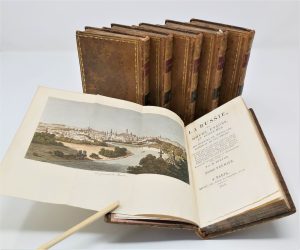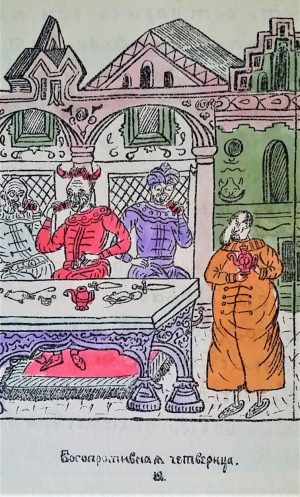Our Notes & References
A very attractive group of documents of Polish-Lithuanian-Russian interest: in fine condition, with bright watercolour illustrations in a handsome contemporary morocco binding and with an unopened brass seal.
The Polish szlachta noble class had existed first in the Kingdom of Poland and in the Grand Duchy of Lithuania, and later, after 1569, in the unified state known as the Polish-Lithuanian Commonwealth. After the Third Partition of this Commonwealth in 1795, the city of Vilnius became part of the Russian Empire under the direct administration of the Lithuania-Vilnius Governorate, which lasted under that name until 1840. Under tsarist rule, the families of the noble (szlachta) class living in the Russian Empire were allowed to maintain their social status and some of their entitlements such as the right to use heraldic coats of arms. However, the imperial administration imposed a requirement on each successive generation of a szlachta family to obtain official certification of their aristocratic status by re-applying to the local authorities for the appropriate documents.
This volume gathers such documents for the Rynkiewicz family.
Requested by Efim Rynkiewicz (c. 1770-1834), the first legal document, written on vellum in an elegant and ornate calligraphy, shows the family’s large and colourful “Herbu Nalewka“, their coat of arms with a jug in its centre. It dates from 24 December 1819 and enumerates in Polish four generations of the Rynkiewicz family, listed in the Nobility book of the Lithuania-Vilnius Governorate. Signed by the Marshall of Vilnius Mykolai Abramovicz and notaries, this document also enumerates the family’s estates and their serfs. It is followed by its Russian translation with an Imperial Russian wet stamp on each leaf and a red wax seal.
A large folding sheet illustrates the main Polish text with a spectacular watercolour schematic family tree, with the Nalewka coat of arms resting at its foot, maintained by a man in armour, sitting with a sword in his hand. It confirms the family right to use it and states that the arms is entered in the Imperial heraldic register. The Russian translation follows the illustration on a bifolium, outlining the scheme of the same family tree, certified with the Imperial stamp of 1819, notarial signatures and the red-wax seal of the Russian Foreign Ministry.
The folder also contains an official Russian 1863 document updating the family’s nobility status; it includes another family tree showing the latest three generations of the Rynkiewiczs.
The Rynkiewicz family served the Polish State, the Lithuania-Vilnius Governorate and then the Russian empire. Kasper Rynkiewicz starts the family tree: he was ennobled in the late 17th century most likely in the Kingdom of Poland. His sons Kozma and Foma purchased an estate in Pacūnai, now Kaunas County, in central Lithuania, and their descendants owned an estate in Šiauliai County, also in present-day Lithuania. In the first half of the 18th century, Kacper’s grandson Ivan (Jan) was taken to the Russian military service and moved with his own family to Russia.
Ivan’s grandson Efim, who requested this document, lived in Russia and lead a distinguished military career, receiving many decorations from the Tsar. He ended his career as Moscow vice-governor and Viatka governor. One of his children, Aleksandr Efimovich, was a member of the Life Guards Cavalry Regiment; he was implicated in the Decembrists’ case and as a punishment in 1826 he was transferred to the Baku garrison battalion as an ensign. His other son Efim Efimovich was a manager of the Moscow Chamber of State Property.
Such documents are sometimes found, but often individually, on paper and in worn condition. This group is unusual for its completeness, overall fresh condition, and its fine binding with brass seal.
Bibliography
Ryndyn I. Z. Rynkevichi. // Istoria, kultura, traditsii Riazanskogo kraia. (online).
Physical Description
Folio (35 x 28 cm). [7] pp. manuscript on vellum in Polish with watercolour illustration of the Nalewka coat of arms, [7] pp. Russian translation with imperial Russian wet stamp on laid paper with Imperial Russian watermark; loose large folding sheet (57 x 44 cm) with watercolour illustration in Polish, [2] pp. in Russian on wove paper with Imperial Russian watermark; later loose bifolium in Russian with an Imperial stamp on wove paper with Imperial Russian watermark.
Binding
Contemporary straight grained red morocco folder, flat spine with gilt rolls and fleurons, green morocco title label with gilt rolls on upper board, borders in green morocco with gilt rolls, gilt lettering in Polish, marbled endpapers, string binding, circular brass seal case on an original cord attached to binding.
Condition
Binding a bit rubbed; leaves slightly rubbed at edges, occasional staining, large illustration leaf restored on a couple of folds; seal unopened.
























































![Image for IAKINF [BICHURIN]. Zapiski o Mongolii. Skt. Peterburg, 1828. #2](https://www.pyrarebooks.com/wp-content/uploads/2023/03/607_1-300x240.jpg)